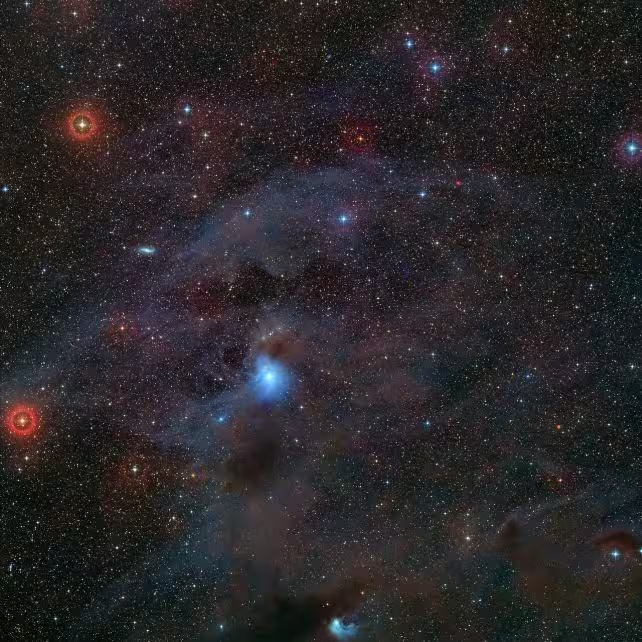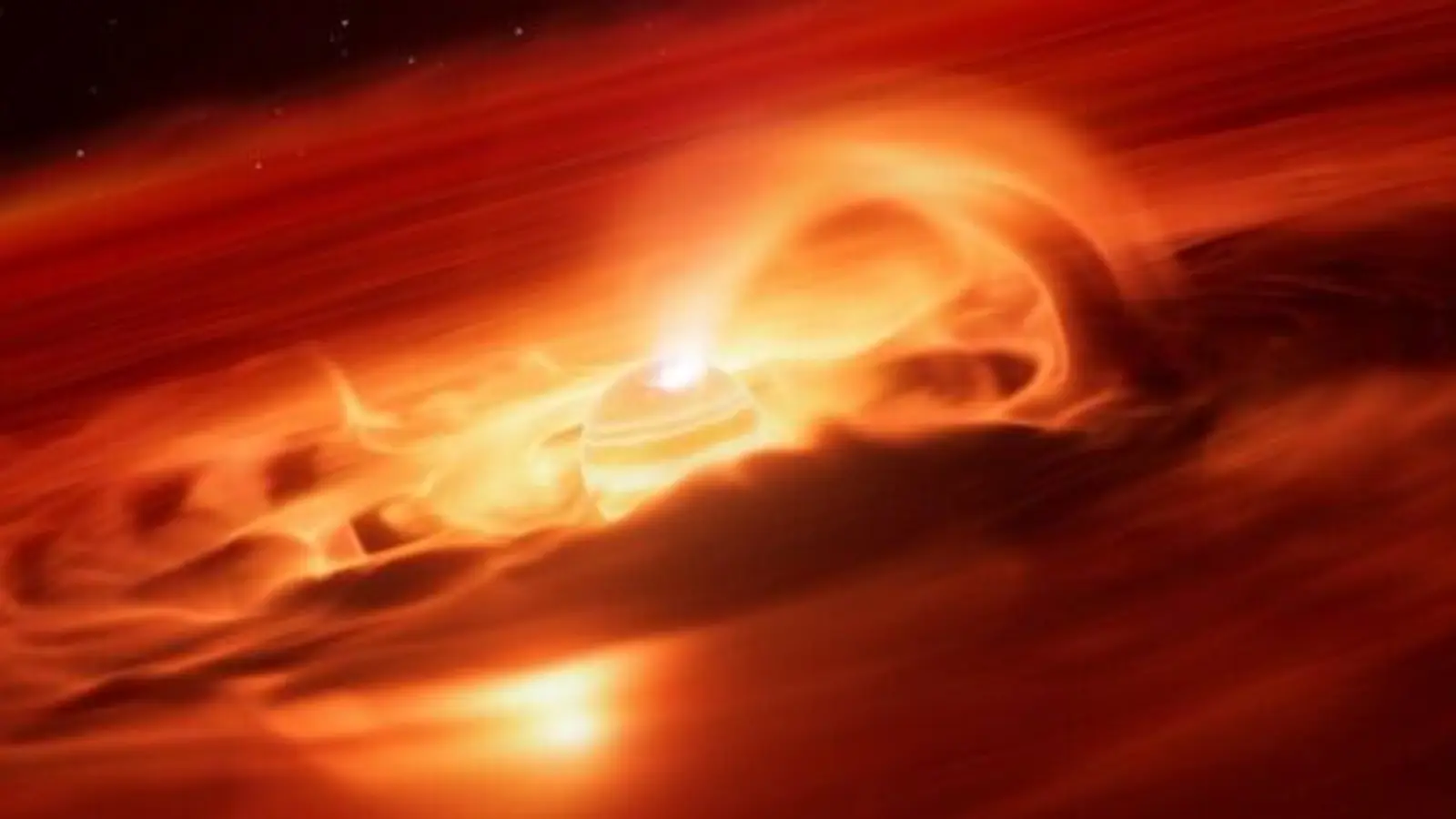6 Minutes
Rogue world caught in a stellar-style growth spurt
A small, free-floating planetary-mass object known as Cha 1107-7626 has been observed undergoing an extraordinary accretion outburst. Astronomers recorded a peak mass-accretion rate near 1 × 10⁻⁷ Jupiter masses per year — roughly 6 billion metric tons per second — sustained for at least two months. This is the strongest accretion episode ever measured for an object in the planetary-mass regime and shows behavior previously seen only in young stars and brown dwarfs.
Cha 1107-7626 has an estimated mass of 5–10 Jupiter masses, well below the 13-Jupiter threshold that typically separates planets from brown dwarfs and far below the 80-Jupiter lower limit for hydrogen-burning stars. Located about 620 light-years away in the Chamaeleon star-forming complex, the object was first identified in 2008 because of signs of accretion from a surrounding disk of gas and dust. The new observations, taken in 2025, make a compelling case that at least some free-floating planetary-mass objects form through a star-like collapse process rather than being ejected planets.
Observations, instruments, and timeline
Astronomer Víctor Almendros-Abad and colleagues carried out a targeted campaign during the first half of 2025. They used the XSHOOTER spectrograph on the European Southern Observatory's Very Large Telescope (VLT) for repeated optical and near-infrared snapshots in April, May, and June, followed by monitoring through July and August that extended into the mid-infrared. The James Webb Space Telescope (JWST) provided complementary infrared sensitivity that helped reveal chemical and thermal changes in the disk during the flare.
Everything appeared typical until late June, when Cha 1107-7626 suddenly brightened. The increase in visible light resembled an EXor burst, a transient brightening classically associated with magnetically funneled, accelerated accretion in young stars. Crucially, the spectrum displayed hydrogen emission features that are the hallmark of magnetospheric accretion — a process in which material from a disk is channeled along magnetic field lines onto the central object.
The archival record shows a similar accretion enhancement in 2016, so these events may be recurrent. When the most recent campaign ended in August the outburst was still ongoing.
Disk properties and chemical signatures
Observations with VLT and JWST indicate Cha 1107-7626 is surrounded by an extensive circumplanetary disk containing silicates and hydrocarbons, resembling the dusty disks commonly found around young stellar objects. During the flare the object brightened by a factor of 3–6 in visible wavelengths, remained nearly unchanged in the near-infrared, and showed a modest increase in the mid-infrared as the inner disk warmed.
JWST spectral data also revealed a hint of water vapor and subtle changes in carbon-bearing molecules, evidence that the accretion burst altered the disk's chemistry. The dust emission features, however, remained broadly constant, implying that the outburst primarily heated and reprocessed gas in the inner disk rather than dramatically changing the dust grain population.

The planetary-mass object Cha 1107-7626 can be found in the Chamaeleon complex. If you could see it in this image, it would be dead in the center. (ESO/ Digitized Sky Survey 2)
Formation scenarios and interpretation
The observations favor a direct-collapse origin for Cha 1107-7626: a dense knot in a molecular cloud that collapsed under gravity to form a low-mass object with a persistent, chemically active disk. This stellar-style formation pathway explains the EXor-like accretion bursts and the magnetically funneled hydrogen emission. An alternative is that the object formed in orbit around a star and was later ejected by gravitational encounters. While not impossible, early ejection would likely disrupt the disk; preserving a substantial, dynamically active disk requires an unusually gentle ejection, making that scenario less probable for this case.
If Cha 1107-7626 and similar free-floating planetary-mass objects (FFPMOs) can form in isolation, it expands the range of pathways by which the Universe produces planetary and substellar bodies. It also raises questions about satellite formation around such objects, the thermal and chemical evolution of their disks, and the demographics of substellar objects in star-forming regions.
Implications for planet and star formation theories
This detection blurs the line between planets, brown dwarfs, and low-mass stars by demonstrating that a planetary-mass body can show accretion physics typically associated with higher-mass objects. Key implications include:
- Evidence that core collapse can produce objects at planetary masses, supporting a formation continuum from stars to planets.
- Confirmation that magnetically mediated accretion operates at very low masses, implying that magnetic fields can regulate growth even for objects several times Jupiter's mass.
- The potential for recurring accretion bursts to influence disk chemistry and the early assembly of satellites or moon systems around FFPMOs.
Follow-up monitoring across optical, near-, and mid-infrared wavelengths will be essential to measure the burst duration precisely, search for periodicity, and map how chemistry and dust evolve over time.
Expert Insight
Dr. Lina Ortega, an observational astrophysicist specializing in low-mass objects, comments: 'Cha 1107-7626 is a remarkable laboratory. Observing EXor-like bursts at planetary masses shows us that the same physical mechanisms that drive stellar accretion can operate at much smaller scales. Continued multi-wavelength monitoring and polarimetric studies will help us constrain the magnetic field and disk geometry that power these events.'
Future prospects and follow-up
Planned observations with high-resolution spectrographs, time-domain surveys, and JWST follow-ups will help determine whether such bursts are common among FFPMOs and how often they recur. Radio and submillimeter facilities can probe the outer disk mass and dynamics, while precision spectroscopy may detect signatures of forming satellites or localized hotspots heated by accretion streams. The discovery also motivates targeted searches for similar objects in nearby star-forming regions to build population statistics.
Conclusion
The record-setting accretion burst observed from Cha 1107-7626 demonstrates that free-floating planetary-mass objects can undergo rapid, star-like growth episodes. This finding strengthens the case that at least some FFPMOs form via direct collapse, expands our understanding of accretion physics at the lowest masses, and opens new avenues for studying disk chemistry, magnetospheric accretion, and the early environments of isolated planetary-mass worlds.
Source: sciencealert


Leave a Comment